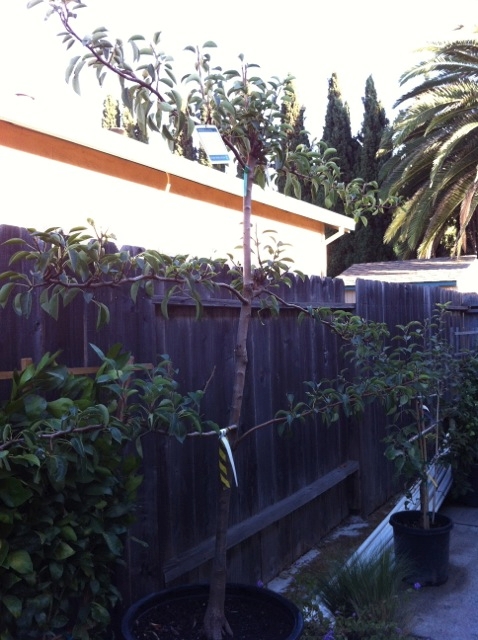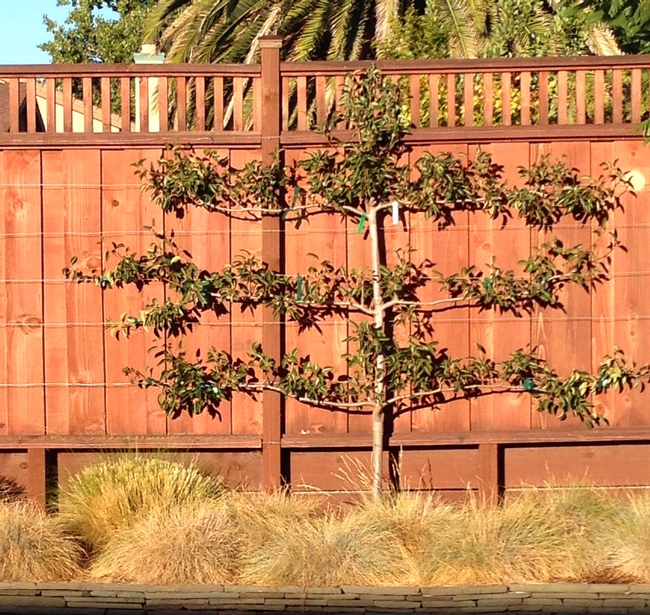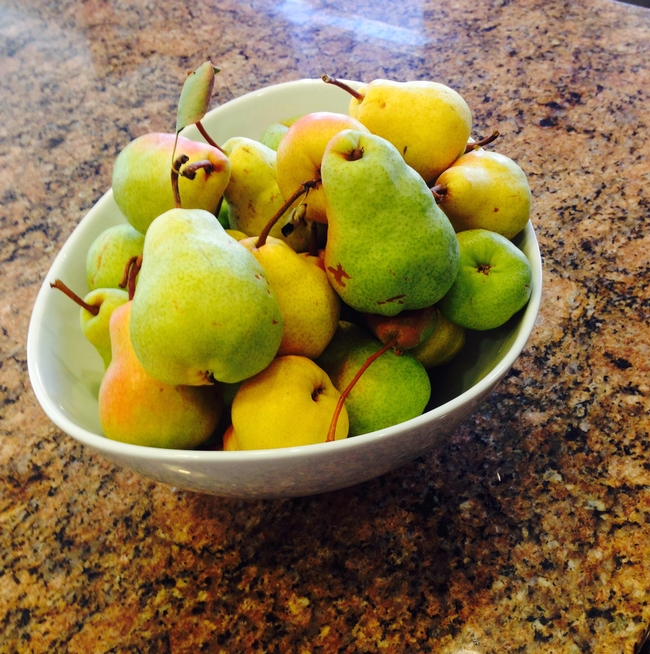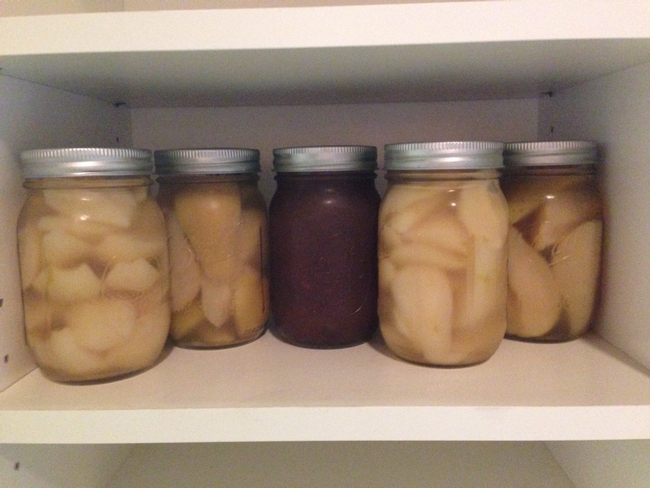This is my first year harvesting Bartlett pears. I've grown pears before, when I lived in the Pacific Northwest, but focused only on Asian pears. I did have a Bartlett tree for pollination purposes, but I'm ashamed to admit that while I harvested the Asian pears, I let those Bartlett pears drop and rot. (Bad gardener - bad, bad gardener).
My pear tree in California was planted in the fall of 2012. I chose an espaliered tree to plant along the street side of my fence line for a number of reasons: (1) the location (SW) received a lot of sunlight in the summer, and plenty of chill in the winter, (2) using an espalier allowed me to grow fruit in a smaller space, (3) harvesting horizontally was much easier, ie, no ladder (4) the tree worked as an interesting landscape plant in addition to producing fruit, and (5) growing the tree out rather than up kept the lovely view of the hills I enjoyed from my backyard intact.
Because I had only harvested Asian pears in the past, it didn't occur to me that there would be any follow-up required for Bartlett pears. After all, Asian pears ripen on the tree, and are then picked, so why not Bartlett too? (See, my "drop-n-rot" technique above).
In general, pear trees will produce fruit in the fourth to sixth year of growth. Nurseries usually sell fruit trees that are one or two years old. My tree was larger than that, and because it was espaliered, it was probably closer to four years old. Last year, was the tree's first true growing season. It produced a single piece of fruit but that disappeared before I could pick it (the most likely culprit being a squirrel). So, my theory on Bartlett fruit harvesting remained unchallenged and unexamined.
My tunnel vision mindset led me to read about the growing, maintenance and pruning of espaliered pear trees, but it stopped me from looking further into the correct harvesting practices for pear cultivars. Thankfully, in the fall of 2013, I enrolled in the Contra Costa Master Gardener (CCMG) program. Through the program, I had access to the UC/ANR website with its wealth of materials. Almost anything I wanted to know about all things related to agriculture and gardening was just a click away. But as important as having the data was, it was equally important to know how to search all of that information. The program taught me how to make the most of my research and break out of my tunnel vision mindset.
Now, back to my pears . . .
This year, the tree had more than three-dozen pears dangling from the branches.
I was able to locate a very helpful publication advising me of the different types of pears, and, when and how, to pick the pears. (Yes, there is a technique — "tilt" the pear horizontal from its usual vertical hanging position. If the pear detaches from the tree, then it's mature; don't force it).
I was so pleased with myself. In fact, I felt very "Master Gardener-y." Fortified by the pear research I had done, I was ready to pick my Bartlett pears and enjoy their deliciousness as soon as they ripened. But the funny — not ha-ha funny — thing is, that the first few pears I picked didn't really ripen. They just sat there on the counter and stayed pretty hard (for those of you experienced in pears, you probably already know why my pears didn't ripen).
Those first picked pears weren't very satisfying to eat, and I was thinking what a bust that was for all that work and research I did. It was clear that I didn't know what I was doing after all. My excitement over the pear harvest had deflated, along with my ego.
The remaining pears weren't ready to pick yet, so I turned my attention to other things, and went about my days working in other areas of my garden. But, the question of why my picked pears didn't ripen was still on my mind. I made a mental note to look into it later.
A few weeks later, while I was volunteering at the CCMG Our Garden in Walnut Creek, I was chatting with a much more experienced Master Gardener about how things were growing in our gardens, and I mentioned that I had some pears to harvest. That's when she told me to be sure to chill the pears after picking so they'll ripen correctly. And just like that, my dilemma was solved. Chill the pears.
Later, at home, I researched the chill times for pear cultivars, and determined that Bartlett pears need between 0-14 days of chilling, then about 5-8 ripening days. Thanks to my fellow master gardener's advice, I was able to properly harvest my pears and avoid having them turn gritty or mealy. My last remaining pears ripened beautifully and were turned into canned pears and pear butter to enjoy this winter.
Sometimes, resource materials – even the vast troves of material available through UC/ANR – aren't enough. Sometimes, it takes talking with other master gardeners to solve a problem. The Master Gardener community brings so much passion and varied experience to the conversation, and is always so willing to share information, resources and tips to support the success of other gardeners – including this novice Master Gardener with so much still to learn.
If you would like to know more about pears, the following are some very helpful publications:
- Pears, The California Backyard Orchard, http://homeorchard.ucanr.edu/Fruits_&_Nuts/Pear/ (Gives a nice annual calendar of tasks for growing pears)
- When to Pick and How To Ripen Pears to Perfection, Oregon State University Extension, http://extension.oregonstate.edu/gardening/node/413 (general information on picking and ripening pears)
- Picking Pears, Filoli Gardener's Reference Sheet, http://www.filoli.org/downloads/garden/gardeners-reference-sheets/pear-ripening.pdf (Provides a great chart showing first pick dates, chilling requirements and ripening days for various pear cultivars)
- Apples and Pears: Calendar of Operations for Home Gardeners, UC Davis, ANR Publication 7258, http://homeorchard.ucdavis.edu/7258.pdf (information on year-round maintenance and growing tips)
- Pear Fact Sheet, UC Davis, Postharvest Technology Center, http://postharvest.ucdavis.edu/PFfruits/PearBartlett/ (provides helpful post-harvest information regarding chilling)
- Growing Temperate Tree Fruit and Nut Crops in the Home Garden and Landscape (Pear), http://homeorchard.ucdavis.edu/plant_pear.pdf(lists pears varieties and harvest periods)
If you would like to know about the Master Gardener Program, click here:http://ccmg.ucanr.edu/Join_Us/



